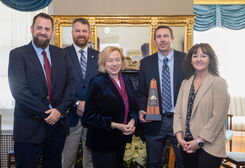
Work starts on bringing two-way traffic to revitalized Augusta downtown
Work has started on opening a one-way stretch of Water Street through the heart of downtown Augusta to two-way traffic, a move that is expected to fuel Water Street's burgeoning retail and residential growth.
The change to downtown's main street will affect two blocks of the roughly four-block downtown. The two-way route is intended to slow traffic, make the street more pedestrian-friendly, and make it easier for those coming from the north to access businesses.
Michael Hall, executive director of the downtown alliance, told Mainebiz in April that the move will have a major impact by simplifying navigability, increasing daily traffic counts and increasing business exposure.
"Out of almost 40 case studies we have looked at, every city that has converted to two-way (regardless of population) has seen net benefits in their central cores resulting in decreased vacancy rates, more business exposure and increased walkability measures," he said. He cited similar planned moves in Waterville and Rockland.
"There's a reason why other cities are paying attention to this trend," he said. "They see the same studies we do and the studies all support conversion."
The city's downtown was largely a service center 20 years ago, but recently has had a resurgence, with more than 70 market rate apartments and condos built or planned where there were none 10 years ago. In addition, 13 restaurants, bars and coffee shops have opened in the past decade.

Historic reversal
The $200,000 project is expected to take about a month and will include paving, striping and new traffic signals.
A more extensive $1.2 million upgrade to parallel Commercial Street, which is remaining one-way, will begin later this year and include a wider sidewalk, road upgrades and a new parking patter. Sargent Corp., of Old Town, is the contractor on both projects.
Water Street and parallel Commercial Street were made one-way in 1945, when the bridge on Bridge Street, at the northern end of the one-way section, was the only one over the Kennebec between Gardiner and Waterville. Traffic on U.S. Route 201, Route 3 and other roads funneled through downtown over the bridge, backing up and hampering commerce.
Making the two blocks between Winthrop and Bridge streets one way going north, and making Commercial Street one-way going south, helped un-jam traffic flow. Memorial Bridge, which is just south of downtown, was built in 1949 and diverted east- and west-bound traffic from Water Street.
The Cushnoc Bridge, in the north end of Augusta, as well as northern Augusta Interstate 95 exits, were later built, further diverting traffic. By the turn of the 21st century, Water Street traffic was largely limited to those doing business in the downtown strip along the Kennebec River.
Waterville, 20 miles north, is also converting its primary downtown street, Main Street, as well as parallel Front Street, to two-way traffic. That work is part of a $9 million project awarded a $7.4 million federal BUILD grant last year. The project is expected to begin next year.














0 Comments